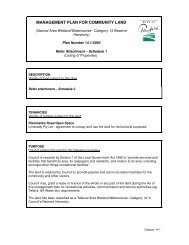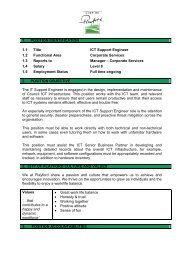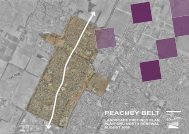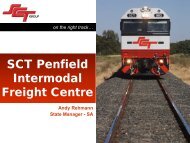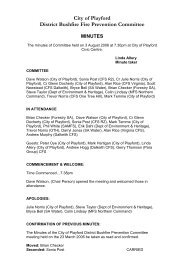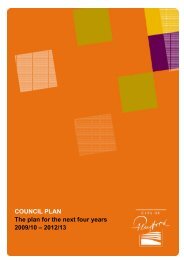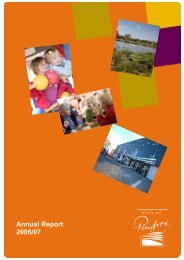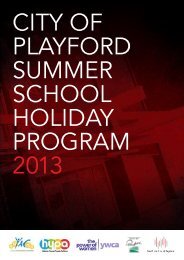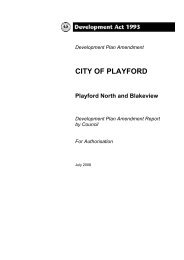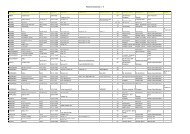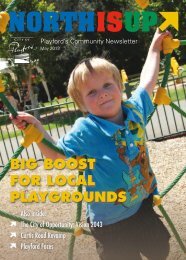Lyell McEwin Health Precinct Master Plan - City of Playford
Lyell McEwin Health Precinct Master Plan - City of Playford
Lyell McEwin Health Precinct Master Plan - City of Playford
- No tags were found...
You also want an ePaper? Increase the reach of your titles
YUMPU automatically turns print PDFs into web optimized ePapers that Google loves.
The current <strong>Lyell</strong> <strong>McEwin</strong> Hospital Stage C redevelopment project will increase the <strong>Lyell</strong><strong>McEwin</strong> Hospital building footprint on the current site, limiting opportunities for futureexpansion, other than vertical opportunities in isolated areas.The health planning and scope <strong>of</strong> services provided at the <strong>Lyell</strong> <strong>McEwin</strong>, which underpinsStage C, is based on a 10 year forward planning window. Forward estimates were based on2006 census data without the benefi t <strong>of</strong> the 30 Year <strong>Plan</strong>.The <strong>Master</strong> <strong>Plan</strong> has taken a 30 year view consistent with the 30 Year <strong>Plan</strong> for GreaterAdelaide. However the immediate recommendations are for the next 5 years.The <strong>Master</strong> <strong>Plan</strong> is not presented as an “End State <strong>Plan</strong>” but rather as a “StrategyDocument” with supporting graphics cognisant that the scope <strong>of</strong> future services cannotbe defi ned at this time and technologies, medical procedures and health programs areevolving rapidly.The <strong>Master</strong> <strong>Plan</strong> provides for the physical expansion <strong>of</strong> the hospital as well as providing forthe allied health activities, retail, pr<strong>of</strong>essional and personnel services towards creating avibrant <strong>Health</strong> <strong>Precinct</strong> with associated urban revitalisation and civic improvements.The <strong>Lyell</strong> <strong>McEwin</strong> <strong>Health</strong> <strong>Precinct</strong> master plan has identifi ed the opportunity for anadditional 30,000 - 40,000 sqm <strong>of</strong> health related development with a capital expenditure <strong>of</strong>$75M - $100M over the next 10 - 15 years.The <strong>Precinct</strong> is expected to be a major driver for jobs and urban renewal as well asservicing the growing population. The <strong>Lyell</strong> <strong>McEwin</strong> <strong>Health</strong> <strong>Precinct</strong> will provideopportunities to expand the local health sector with associated urban revitalisation andpublic realm improvements. Once established as an education, training and serviceshub for the health sector the <strong>Precinct</strong> is expected to attract medical. manufacturing andpotentially pharmaceutical industries adjacent to the <strong>Precinct</strong>.Figure 1.3 : Northern Adelaide 30 Year <strong>Plan</strong> Proposals6LYELL McEWIN HEALTH PRECINCT - MASTER PLAN
Figure 1.4 : Dwelling Targets <strong>Plan</strong>Figure 1.5 : Job Targets <strong>Plan</strong>LYELL McEWIN HEALTH PRECINCT - MASTER PLAN 7
The Vision Statement, taken from the Creating a <strong>Health</strong> <strong>Precinct</strong> Report, is as follows:The <strong>Lyell</strong> <strong>McEwin</strong> <strong>Health</strong> <strong>Precinct</strong> will service Northern Adelaide’s Premier TertiaryHospital by delivering new models for higher education and training, teaching andresearch to provide a skilled workforce for the health needs <strong>of</strong> Northern Adelaide.’The Guiding Principles, drawn from the Vision Statement and the consultations during thecourse <strong>of</strong> the master planning process are outlined below. The fi rst three principles are“Strategic” in nature focusing on overall purpose with the second three Principles being“Site” related.1. Meeting the <strong>Health</strong> Needs <strong>of</strong> Northern Adelaide / SA Communities2. Supporting the ‘Core Functions’ <strong>of</strong> <strong>Lyell</strong> <strong>McEwin</strong> Hospital3. Bringing economic and social benefit to the broader area4. Creating a ‘Special Place’ by• Defining Built Form• Open Space Design / Landscape Enhancements• Entry Points / Wayfinding / Public Art5. Improving Access /Connectivity by• Defining Road Hierarchy• Appropriate Car Parking• Walkability / Safety/ Disability Access• Wayfinding• Public Transport6. Demonstrating Environmental Sustainability by• Water Conservation• Energy Conservation• Waste Management8LYELL McEWIN HEALTH PRECINCT - MASTER PLAN
2.0 ApproachThe master planning process incorporated the following Stages over the period March-June, 2011.Stage 1 - Initial Urban Design and Site AnalysisStage 2 - Property and Demand AnalysisStage 3 - Defi ne Opportunities and Concept <strong>Plan</strong>sStage 4 - Develop Draft <strong>Master</strong> <strong>Plan</strong>Stage 5 – Finalisation <strong>of</strong> the <strong>Master</strong> <strong>Plan</strong>The consulting team was afforded a detailed start up briefi ng by the Client’s ProjectManagement Group in March 2011, an extended site tour and workshop session with theSteering Committee in April and a design workshop session with the Steering Committeeand other key stakeholders in May 2011. The Hospital co-ordinated meetings withPractioners, Mental <strong>Health</strong> Services, Aboriginal <strong>Health</strong> Services and Volunteers.The following individuals and organisations were consulted as part <strong>of</strong> the master planningprogram and their community greatly valued.• Pr<strong>of</strong>essor Justin Beilby, Executive Dean , Faculty <strong>of</strong> <strong>Health</strong> Sciences, University <strong>of</strong>Adelaide• Pr<strong>of</strong>essor Allan Evans, Pro Vice Chancellor, <strong>Health</strong> Sciences, University <strong>of</strong> SouthAustralia• Dr Martyn Evans, Community Engagement, University <strong>of</strong> Adelaide• Mr Joe Bennink, Community Engagement, University <strong>of</strong> Adelaide• Pr<strong>of</strong>essor Esther May, Dean <strong>of</strong> <strong>Health</strong> and Clinical Education, University <strong>of</strong> SouthAustralia• Ms Anthea Williams, Executive Offi cer, <strong>Health</strong> Sciences, University <strong>of</strong> South Australia• Dr Wayne Harvey, Business Developement Manager, University <strong>of</strong> South Australia• Ms Alison Roberts, General Manager, Education Programs and Services, TAFE, SA• Dr Jim Young, Practitioner and former Director <strong>of</strong> Medicine at <strong>Lyell</strong> <strong>McEwin</strong> Hospital• Ms Barbara Magin, Chief Executive Offi cer, Northern Division <strong>of</strong> General Practioners• Ms Julie-Anne Burgess, Area Director, Northern Adelaide <strong>Health</strong> ServicesLYELL McEWIN HEALTH PRECINCT - MASTER PLAN 9
• Ms Vanessa Owen, Acting General Manager, <strong>Lyell</strong> <strong>McEwin</strong> Hospital• Ms Irina Lindquist, Director, Engineering and Building Services, <strong>Lyell</strong> <strong>McEwin</strong> Hospital• Mr Peter Mullen, Manager Corporate Services Northern Adelaide <strong>Health</strong> Services• Mr Andy Fryar, Chief Executive Offi cer, <strong>Lyell</strong> <strong>McEwin</strong> Hospital Volunteers Inc.• Ms Leona Agis, Manager, Muna Paiendi, Aboriginal <strong>Health</strong> Services• Mr Mark Buckerfi eld, Director, Asset Services, Department <strong>of</strong> <strong>Health</strong>• Mr Tim Packer, Projects Team Leader, Asset Services, Department <strong>of</strong> <strong>Health</strong>• Mr Brendan Hewitt, Director Corporate and Clinical Support, Adelaide <strong>Health</strong> Services• Mr Sam Raslan, Property Owner Elizabeth Vale Shopping Centre• George Morias, Department for Transport Energy and Infrastructure (DTEI)• Mr Andrew Riggs, Business Advisor, Innovate SA, Department <strong>of</strong> Trade and EconomicDevelopment• Ms Sharon Bingham, Chief Executive Offi cer, Calvary Central District Hospital• Mr Glenn Docherty, Mayor, <strong>City</strong> <strong>of</strong> <strong>Playford</strong>• Mr Greg Pattinson, Group Manager <strong>City</strong> Development, <strong>City</strong> <strong>of</strong> <strong>Playford</strong>• Mr Chris Hannaford, Manager Economic Development, <strong>City</strong> <strong>of</strong> <strong>Playford</strong>• Mr Paul Johnson, Principal Policy <strong>Plan</strong>ner, <strong>City</strong> <strong>of</strong> <strong>Playford</strong>• Brenton Hall, Traffi c Engineer <strong>City</strong> <strong>of</strong> <strong>Playford</strong>Extensive investigations and consultations were involved in the master planning programand are reported on in the following sections <strong>of</strong> this report.10LYELL McEWIN HEALTH PRECINCT - MASTER PLAN
0 200400800mElizabeth Regional Centre3.0 Investigations3.1 Regional ContextThe <strong>Lyell</strong> <strong>McEwin</strong> Hospital (LMH) is located 25 kilometres north <strong>of</strong> the Adelaide GPO, 5kilometres south from the Elizabeth Regional Centre and 3 kilometres north <strong>of</strong> the SalisburyTown Centre.The LMH is well served by arterial roads with a primary frontage to John Rice Avenue,connecting with Main North Road and Phillip Highway.Salisbury Town Centre<strong>Lyell</strong> <strong>McEwin</strong> HospitalCalvary Central Districts HospitalMajor open space is provided within the near locality including open space buffers betweenresidential and industry, as well as recreation facilities to the west and the Little Para RiverLinear Park to the south.Major industrial employment clusters are established to the west with a focus on GeneralMotors Holden, Defence Science Technology Organisation and the Edinburgh Parks areafurther afi eld.Figure 3.1 outlines the Regional Context.The <strong>Health</strong> <strong>Precinct</strong> Feasibility Study, June 2010, identifi ed some 192 health business inthe <strong>City</strong> <strong>of</strong> <strong>Playford</strong> including specialist services, medical, oral health service providers andretailers. Most <strong>of</strong> the services were in the Centre zones or along Main North Road. A similarnumber <strong>of</strong> health businesses would be within the <strong>City</strong> <strong>of</strong> Salisbury with a focus on theSalisbury Town Centre and more recently Mawson Lakes Town Centre.Legend:HospitalsTransit StationOpen Space Schools 400 m RadiusRailway LineShopping CentresIndustryThe Elizabeth GP Plus <strong>Health</strong> Care Centre has been established at the Elizabeth <strong>City</strong> Centreand the <strong>Playford</strong> North GP Super Clinic will be established in the new Town Centre north <strong>of</strong>Curtis Road adjacent to the new school as part <strong>of</strong> the <strong>Playford</strong> Alive Project. Adelaide UniCare will also establish a clinical training facility adjacent to the Super Clinic.100<strong>Lyell</strong> <strong>McEwin</strong> <strong>Health</strong> <strong>Precinct</strong>31242SD01DATE: 20/06/11John Rice Avenue/Haydown Roadwww.hamessharley.com.au +61 8 81123400Figure 3.1: Regional ContextCalvary Central District Hospital is located two kilometres to the south west <strong>of</strong> the LMHadjacent to the Little Para River Linear Park within the <strong>City</strong> <strong>of</strong> Salisbury.LYELL McEWIN HEALTH PRECINCT - MASTER PLAN 11
3.2 <strong>Lyell</strong> <strong>McEwin</strong> HospitalThe LMH commenced operations in 1958.The LMH has gone through a number <strong>of</strong> extensions and refurbishments most recentlyStage A - $91.2 million (2000-04) and Stage B - $43.5 million (2005-2009). The mentalhealth unit resulted from the fi nal works <strong>of</strong> Stage B.Stage C -$202 million - has been approved for construction over the next four years withthe construction <strong>of</strong> the 1,254 space decked car park as a pre-condition <strong>of</strong> development and isalready completed.A Stage D is contemplated but not yet detailed or approved by Government.An aerial photograph <strong>of</strong> the current LMH site is provided as Figure 3.2.Stage C involves the construction <strong>of</strong> the following:• 96 bed acute inpatient facilities;• Ambulatory care building to accommodate expanded outpatient and allied healthservices;• New support services building to accommodate expanded Women’s <strong>Health</strong> Centrefacilities. Maternal Assessment Unit, administration, research, education, clinician<strong>of</strong>fi ces and relocated and expanded back <strong>of</strong> house services; and• A range <strong>of</strong> internal reconfi gurations, relocations, refurbishments and upgrade worksto optimise the existing and expanded functional requirements and in particular thetransfer <strong>of</strong> Muna Paiendi from the present transportable building on Haydown Road tothe former Metropolitan Domiciliary Care building on the corner <strong>of</strong> Oldham Road andMark Road.Figure 3.2: Aerial Photo <strong>of</strong> current LMH site12LYELL McEWIN HEALTH PRECINCT - MASTER PLAN
The built form will refl ect the form, materials and fi nishes <strong>of</strong> Stage A and B and will initiallybe contained within built form dispersed over a basement and 2 levels above ground. Allnew buildings will meet Post Disaster provisions, be designed to carry additional fl oors andfeature Ecological Sustainable Development Strategies. The LMH is reported as the mostESD compliant hospital in Australia.The existing LMH and location <strong>of</strong> Stage C developments are shown in Figure 3.3The current gross fl oor area <strong>of</strong> the LMH is approximately 32,570 sqm.The LMH has 309 beds including 50 Mental <strong>Health</strong> beds. There are also some 85barouches and chairs for same day treatments and scheduled services e.g. chemotherapyand dialysis. Stage C will increase bed numbers to 394, with 100 barouches and treatmentchairs to be provided in the expanded hospital.The LMH has an employee base <strong>of</strong> 1,922 persons refl ected in 1,609 Full Time Equivalents.This does not include mental health, Muna Paiendi (Aboriginal <strong>Health</strong> Centre) or renalservices which are managed under separate budget lines. Estimates are that there are2,500 staff presently on the site which will increase to 4,000 staff at the end Stage C. There isalso a sizable volunteer program involving approximately 500 persons.The LMH will provide a full range <strong>of</strong> major complex medical, surgical, diagnostic emergencyand support services for adults and a range <strong>of</strong> surgical and medical services for womenand children. Surgical services at the LMH will be expanded to <strong>of</strong>fer a more comprehensiveservice to people living in the north including:• Cardiac services including interventional cardiology;• Urology;• Ophthamology;• Cancer services including radiation services; and• General medicine.Figure 3.3: Location <strong>of</strong> Stage C developmentsLYELL McEWIN HEALTH PRECINCT - MASTER PLAN 13
Mental health services will be expanded to include both adult and aged acute mental healthservices. Community mental health will also be expanded by the provision <strong>of</strong> a communityrecovery centre in the <strong>City</strong> <strong>of</strong> <strong>Playford</strong> area.The SA <strong>Health</strong> <strong>Plan</strong> devotes signifi cant resources to activities in the northern Adelaidearea recognising the increase in demand from current residents and employees, and thegrowing population.3.3 LocalityThe broader locality features predominantly single storey detached residential dwellings.There is very limited infi ll or residential redevelopment to date in the locality. While the areawas established by the former South Australian Housing Trust, many <strong>of</strong> the houses havenow been sold to private land owners.Some support health services are present in the near locality with diagnostic, chiropractic,podiatrist, physiotherapy and general practice rooms along John Rice Avenue, HaydownRoad and on the corner <strong>of</strong> Haydown and Oldham Road. <strong>Health</strong> related equipment hire isprovided from the Elizabeth Vale Shopping Centre to the east <strong>of</strong> the LMH site.The Elizabeth Vale Neighbourhood Shopping Centre was constructed in the 1960s, is inan aged condition and is considered an underutilization <strong>of</strong> the site given the single storeyconstruction, large open areas and ineffi cient car parking layout.Property ownership is shown in Figure 3.4.A Site Assessment <strong>of</strong> the locality was carried out and is refl ected in the Figures 3.5 - 3.8detailing the grouped land parcels, signifi cant buildings, movement networks and openspace areas.Legend:Minister for <strong>Health</strong>Private OwnershipHousing SAMinister for Education<strong>City</strong> <strong>of</strong> <strong>Playford</strong>RaslanIntex EquitesESMEC HouseFigure 3.4: Property Ownership14LYELL McEWIN HEALTH PRECINCT - MASTER PLAN
Figure 3.5: Land ParcelsFigure 3.6: Signifi cant BuildingsArterial Collector LocalFigure 3.7: Movement NetworksFigure 3.8: Open SpacesLYELL McEWIN HEALTH PRECINCT - MASTER PLAN 15
3.4 Traffi c and TransportAccessThe site, whilst being somewhat removed from the nearest railway stations, is neverthelesswell located for the establishment <strong>of</strong> the <strong>Precinct</strong> that is connected to rail, bus and bicyclenetworks as well as businesses in the local area.The road system would appear to have signifi cant capacity to underpin further development,however future development will need to be tested to estimate the additional traffi cgeneration and distribution, and the requirements <strong>of</strong> the road network, particularly at themain entry into the <strong>Precinct</strong>.John Rice Avenue is an arterial road in the care and control <strong>of</strong> DTEI and provides connectionbetween Main North Road and Phillip Highway that connects Elizabeth Regional Centre andSalisbury Town Centre. Haydown Road is a distributor level road in the care and control <strong>of</strong>the <strong>City</strong> <strong>of</strong> <strong>Playford</strong>, and Oldham Road, Trembath Road and Mark Road are all local roads.Refer Figure 3.9.The main hospital entry and at-grade car park is accessed from Oldham Road, and therecently constructed multi-storey car park for staff and visitors has its entrance <strong>of</strong>f MarkRoad. The majority <strong>of</strong> staff and visitors access these locations from the junction <strong>of</strong> John RiceAvenue and Haydown Road.The junction <strong>of</strong> John Rice Avenue and Haydown Road has been classifi ed as a BlackSpot. The Department for Transport Energy and Infrastructure (DTEI) prepared a traffi csignal design at this junction that includes a sheltered right turn into Haydown Road and asignalised pedestrian crossing. Liaison with DTEI has identifi ed that the benefi t-cost ratio forthis junction upgrade was not met, and several applications for black spot funding have notbeen successful to date.Figure 3.9: Existing Road Networks16LYELL McEWIN HEALTH PRECINCT - MASTER PLAN
The access driveway for emergency vehicles is <strong>of</strong>f <strong>of</strong> Oldham Road and separated fromother traffi c. It is accessed in most instances via Haydown Road. The Emergency accessroute must not be compromised with any future development or modifi cations to theroadway.In the design workshop, Haydown Road was identifi ed as being a Main Street, and TrembathRoad a central spine constructed as a shared zone.Car ParkingThere are currently 1,780 car parks on the site (Refer Figure 3.10) comprising:• 1,254 spaces in the recently constructed multi-deck; and• 526 at-grade spacesStage C works include the removal <strong>of</strong> the car park adjacent to John Rice Avenue. This willresult in a total <strong>of</strong> 1,550 <strong>of</strong>f-street car parks at the end <strong>of</strong> stage C works. The Multi-deck carpark currently has a 70% utilisation rate at the peak (890 cars parked). Even though thereare spaces remaining, there is signifi cant all day parking in the surrounding streets. A spotsurvey counted over 100 cars parked on near streets and it is expected that most <strong>of</strong> theseare staff. This may be a result <strong>of</strong> the ease <strong>of</strong> on-street parking or the avoidance <strong>of</strong> the fees inthe multi-deck.A previous traffi c report by Shane P. Foley & Associates, August 2010 identifi ed that therewould be a parking shortfall <strong>of</strong> around 100 spaces on the hospital grounds after completion<strong>of</strong> Stage C. The report suggested that parking in the street be maintained to cover thisshortfall. Therefore, consideration <strong>of</strong> how on-street parking is utilised and managedthroughout the <strong>Health</strong> <strong>Precinct</strong> is critical. It should be noted that the parking estimates in thereport were based on broad data that was available and should be reassessed with moreaccurate data input.Figure 3.10: Car parking (after Stage C)LYELL McEWIN HEALTH PRECINCT - MASTER PLAN 17
It was identifi ed in the workshop that the multi-deck car park was a considerable distanceaway for many patients to walk to/from the LMH, particularly non-ambulatory patients. Carparking should be distributed throughout the <strong>Precinct</strong> with numerous drop <strong>of</strong>f / pick-uppoints. An additional multi-deck car park may be appropriate as part <strong>of</strong> a redevelopment<strong>of</strong> the Neighbourhood Shopping Centre and associated uses to provide car parking on theeastern side <strong>of</strong> the Hospital.Rail TravelThe nearest rail stations on the Adelaide to Gawler line are approximately 30 minuteswalking distance or 10 minutes by bicycle. This rail line links the <strong>Precinct</strong> to:• GP Plus Superclinic at Elizabeth;• Munno Para Shopping Centre;• Elizabeth transport node and regional centre, and• Salisbury transport node and town centre.It should also be noted that future electrifi cation <strong>of</strong> the Adelaide to Gawler line (by 2013) willimprove frequency and speed <strong>of</strong> the rail service and is likely to be more attractive to users.Bus TravelAnecdotal evidence has suggested that the bus services to LMH are infrequent andinconvenient. However, in 2008 a major upgrade <strong>of</strong> the bus routes and timetablessignifi cantly improved the bus service to the Hospital. In addition, there are serviceupgrades planned to commence in July 2011. There may be a lack <strong>of</strong> awareness <strong>of</strong> theseservice changes and a careful review <strong>of</strong> hospital staff, patients and visitors' public transportneeds is required to identify the gaps. Refer Figure 3.11.Figure 3.11: Bus route18LYELL McEWIN HEALTH PRECINCT - MASTER PLAN
Metro Adelaide bus services (205, 224, 400 and T500) service the LMH, with bus routesalong three sides <strong>of</strong> the hospital (John Rice Avenue, Haydown Road and Oldham Road).The combined services form a Go Zone with 15 minute frequency between 7:30am and6:30pm. In 2008, the bus services to LMH were improved considerably, and included thePhillip Highway routes being re-directed to link directly to the hospital. The high frequencydirect buses are north-south routes linking the hospital with the transport nodes <strong>of</strong>Salisbury and Elizabeth. At these nodes, users can change buses to travel east-west. Inaddition, the timetables are designed to connect to the rail service with a 5 minute transfertime. The bus routes are shown in Figure 3.10.These routes have wheelchair accessible buses at all times and link the <strong>Precinct</strong> to:• Calvary Central District Hospital;• Transport interchanges at Elizabeth, Salisbury and Paradise;• Mawson Lakes Campus; and• Adelaide CBD, including the Royal Adelaide Hospital.There are currently no direct bus routes from the <strong>Precinct</strong> to Munno Para, <strong>Playford</strong> Aliveor Modbury Hospital. However, bus service upgrades planned for July 2011 will includea direct bus (560) from LMH to Modbury Hospital as well as major upgrades <strong>of</strong> the 500service.Personal safety at bus stops was raised as an issue at the workshops, particularly afterdark. This currently dissuades people from using public transport. Bus stop upgrades,including shelter and lighting, should be considered as part <strong>of</strong> streetscape improvementson John Rice Avenue and in Haydown and Oldham Roads,Other bus services to the hospital are available as requested by patrons and include the <strong>City</strong><strong>of</strong> <strong>Playford</strong> community bus and the Red Cross transport services.LYELL McEWIN HEALTH PRECINCT - MASTER PLAN 19
CyclingHaydown Road and John Rice Avenue are designated routes in the DTEI Bikedirect network(refer Figure 3.12). Although they are cycling routes, there are no bicycle lanes marked,and there is a general lack <strong>of</strong> coherent cycling facilities in the area.The Little Para shared path is within a two minute cycling distance. This path is used mainlyfor recreation and runs adjacent to the River between Main North Road (Salisbury Heights)and Kings Road, Paralowie.The State Government has identifi ed the Adelaide to Gawler rail line as a future Greenway.This will comprise a shared path along its entire length and is likely to encourage cycling inthe area. There are 19 bicycle storage spaces in the decked car park.WalkingThere are relatively high volumes <strong>of</strong> pedestrian traffi c crossing Haydown Road betweenthe hospital and the Elizabeth Vale Shopping Centre. This is facilitated satisfactorily with asignalised crosswalk and wide median islands.John Rice Avenue is diffi cult to cross with four lanes <strong>of</strong> traffi c and no median island. Thejunction alignment <strong>of</strong> John Rice Avenue and Haydown Road allows for a relatively highspeed left turn entry into Haydown Road across the line <strong>of</strong> pedestrian travel and the kerbramps are located at an acute angle to oncoming traffi c.It was identifi ed at the workshop that a ‘compact’ precinct would result in a more walkableprecinct.Figure 3.12: Cycling route20LYELL McEWIN HEALTH PRECINCT - MASTER PLAN
Traffi c & Transport RecommendationsIn summary it is recommended that the following traffi c tasks be undertaken:Main Ambulance Access Alternative Ambulance Access Signalised Pedestrian CrossingPedestrian AccessMajor Junction Upgrade(traffi c signals and cross walk)Major Junction UpgradeFigure 3.13: Local Traffi c and Ambulance Access• Refer to Figure 3.13 for the local traffi c and ambulance access;• Liaise with the Department for Transport, Energy and Infrastructure to further refi ne;their signalised intersection for the junction <strong>of</strong> John Rice Avenue and Haydown Road inline with 'High Street' / 'Main Street' concept;• Develop Haydown Road from John Rice Avenue to Oldham Road as a ‘High Street’withenhanced footpath environment in the short to medium term on completion <strong>of</strong> Stage C.Ensure emergency vehicle access is not impeded with any road modifi cations;• Test future land use developments to estimate car parking demand to determineappropriate car parking provision;• Analyse public transport services following new routes/timetables in July 2011;• Provide educational awareness <strong>of</strong> upgraded bus services;• Identify the gaps in the public transport services and liaise with Adelaide Metro forfuture timetable/route upgrading;• Provide a shuttle bus between the <strong>Precinct</strong> and the near rail station;• Existing bus stops are well located around the <strong>Precinct</strong> along Haydown Road, OldhamRoad and John Rice Avenue. Public transport use would be encouraged by enhancing/upgrading these bus shelters and public lighting in the short term. In the longer term, amini-interchange could be developed to support the broader <strong>Precinct</strong>; either as a streetbased system or a public transport hub;• Provide additional secure bicycle parking throughout the <strong>Health</strong> <strong>Precinct</strong>;• Liaise with Adelaide Metro to provide bicycle lockers at the Nurlutta and ElizabethSouth rail stations;• Provide bicycle hire/loan within the <strong>Precinct</strong>;• Figure 3.14 depicts a possible Northern Region <strong>Health</strong> Transit Link route. This isindicative and subject to defi ning potential passenger demand and analysis <strong>of</strong> publictransport services; and• Figure 3.15 depicts a possible future cycling routes to link the <strong>Precinct</strong> with Nurluttaand Elizabeth South rail stations and Calvary Central Districts Hospital.LYELL McEWIN HEALTH PRECINCT - MASTER PLAN 21
0 500m1 km2 km<strong>Playford</strong> Alive GP PlusMunno ParaDistrict CentreElizabethSouthStationElizabeth Regional Centre +GP Super Clinic<strong>Lyell</strong> <strong>McEwin</strong> HospitalElizabeth Regional CentreSalibury Town CentreNurluttaStationModbury HospitalLegend:Proposed Cycle RoutesShuttle Bus - <strong>Precinct</strong> to RailCalvary HospitalLittle Para Shared PathAdelaide - Gawler Railway LineGreenwayLegend:<strong>Health</strong> Transit LinkRailwayProposed Mass Transit Corridor (30 Year <strong>Plan</strong>)250 <strong>Lyell</strong> <strong>McEwin</strong> <strong>Health</strong> <strong>Precinct</strong>31242SD01John Rice Avenue/Haydown Roadwww.hamessharley.com.au +61 8 81123400DATE: 20/06/11<strong>Lyell</strong> <strong>McEwin</strong> <strong>Health</strong> <strong>Precinct</strong>John Rice Avenue/Haydown Road31242100DATE: 20/06/11 SD010 200400800mwww.hamessharley.com.au +61 8 81123400Figure 3.14: Northern Adelaide <strong>Health</strong> Transit LinkFigure 3.15 Cycling/Shuttle Bus Connections22LYELL McEWIN HEALTH PRECINCT - MASTER PLAN
3.5 Utility ServicesThe hospital site and surrounding properties are well serviced with sewer, water, gaselectricity and telecommunications including the high speed/high capacity SABRENet fi bre lineconnecting the States major hospitals, education and research facilities. The utility servicesare described below.Figure 3.16: Domestic & Fire WaterFigure 3.17: Natural GasDomestic and Fire WaterThe domestic water and fi re water supplies to the <strong>Precinct</strong> are substantial due to the proximityto the adjacent 600mm diameter trunk main in John Rice Avenue. The SA Water pressurezone is satisfactory for multi-purpose low rise developments. Tanks and pumps can beexpected for medium to high rise developments. Refer Figure 3.16Natural GasNatural gas supplies to the precinct are substantial due to infrastructure demanded by thehospital. The 100 diameter supply mains will be satisfactory for multi-purpose developmentsin the area and no upgrade to the <strong>Precinct</strong> is anticipated. Refer Figure 3.17.Figure 3.18: Sanitary drainageFigure 3.19: Power suppliesSanitary DrainageLocal SA Water infrastructure provides substantial capability for current requirements andcapability for future expansion. The ability for any proposed development to interconnectto adjacent infrastructure is available without the requirement for additional evaluation byAuthorities. Refer Figure 3.18Power SuppliesTo the north <strong>of</strong> the <strong>Precinct</strong>, ETSA has established the Elizabeth South Sub Station. Thissupplies demand to Local Industry, the Hospital and Domestic Product. Locally suppliesfeed the hospital and adjacent spaces although the true demand upon this network has notbeen fully assessed as part <strong>of</strong> these master planning activities. Based upon the existinginfrastructure to the adjacent development zones, some upgrade <strong>of</strong> supply will be requiredand this will most likely take the form <strong>of</strong> new transformers within the bounds <strong>of</strong> futuredevelopments. Refer Figure 3.19.LYELL McEWIN HEALTH PRECINCT - MASTER PLAN 23
A less likely outcome is the requirement to supply new high voltage overhead provisions to thezone, which can be accommodated (albeit at the expense <strong>of</strong> the project) if required. The fi naloutcome will be entirely driven by the maximum demand <strong>of</strong> the proposed development.Research and Education Broadband NetworkA connection to the SABERNet Network exists and this feed can be interfaced with adjacentsites as required should the development zones demand the required broadband Researchand Education link. Refer Figure 3.20.Figure 3.20: Research & Education BroadbandNetworkFigure 3.21: Communications (Fibre)Communications (Fibre)High speed fi bre runs adjacent a number <strong>of</strong> development zones and interconnection iscommonly made for new developments. With the modern day requirement for ‘connection’the opportunity for fi bre and it’s relatively close location allows for a multitude <strong>of</strong> opportunitiesaround the <strong>Precinct</strong>. Refer Figure 3.21.Communications (Copper)Local telecommunications via copper are suitable for current developments. With theproximity <strong>of</strong> fi bre communications across the <strong>Precinct</strong>, there will likely be some upgrade <strong>of</strong>local copper infrastructure based upon the capabilities <strong>of</strong> the local exchange but an exhaustiveoverhaul will be avoided due to the presence <strong>of</strong> the fi bre network to assist with data and voicecommunications. Refer Figure 3.22.Figure 3.22: Communications (Copper)Utility Services RecommendationsIn summary it is recommended that as future stages and individual developments areidentifi ed in terms <strong>of</strong> location and size that discussions with service providers be initiated24LYELL McEWIN HEALTH PRECINCT - MASTER PLAN
4.0 Constraints &OpportunitiesThe task <strong>of</strong> developing a high quality innovative urban space integrating with existing andproposed facilities on the Core Site will require a considered approach to land use and builtform confi guration, coupled with an effi cient, legible movement framework and streetscapeimprovements. The <strong>Master</strong> <strong>Plan</strong> will also determine the optimal location for the identifi edfacilities.4.1 ConstraintsThe current <strong>Lyell</strong> <strong>McEwin</strong> Hospital Stage C redevelopment project will increase the LMHbuilding footprint on the current site.Stage C buildings have been designed to carry extra fl oors in future should they be required.Other opportunities for vertical expansion are only available in isolated areas as the Stage Aand Stage B areas <strong>of</strong> the Hospital were not engineered for additional building height.More broadly speaking there is considerable potential to secure additional land for variousactivities and facilities and / or promote appropriate developments near the Hospital as part<strong>of</strong> the broader <strong>Precinct</strong> whilst acknowledging the various land owners and differing land usesurrounding the site. Refer to Figure 4.1.The road and transport system has signifi cant capacity to underpin further development. Thesite, whilst being somewhat removed from the nearest railway stations, is nevertheless welllocated for the establishment <strong>of</strong> a <strong>Precinct</strong> that is connected to rail, bus and bicycle networksand businesses in the local area.Improvements are required to the movement system and road network but this is not aconstraint to the development <strong>of</strong> the <strong>Precinct</strong>.LYELL McEWIN HEALTH PRECINCT - MASTER PLAN 25
Education and Training with the Universities and TAFEThe University <strong>of</strong> Adelaide and the University <strong>of</strong> South Australia are members <strong>of</strong> the LMH<strong>Health</strong> <strong>Precinct</strong> Steering Committee and have indicated strong interest in having a educationand training facilities within or associated with the Hospital. Flinders University has alsoexpressed an interest. TAFE has also expressed interest for allied health services trainingand manufacture <strong>of</strong> medical and laboratory equipment, testing and associated activities.The University <strong>of</strong> South Australia (UniSA) is interested in establishing a clinical school tosupport teaching and research in a wide range <strong>of</strong> disciplines and support engagement inhealth-related matters. The University would seek a site near the Hospital but does notneed to be on the Hospital Site. The clinical school envisaged by UniSA would be in the order<strong>of</strong> 4,000 sqm.Research and LaboratoriesThe Universities have also indicated interest in research facilities including laboratories inassociation with the Hospital. The facilities would ideally be within the Hospital to maximiseinteraction between staff but also could be in near proximity.Simulation FacilityAs part <strong>of</strong> the education and training facilities a medical simulation centre has beenadvanced by the Hospital Management. Ideally this facility would be within the Hospital andconveniently located near the education and training facilities.LYELL McEWIN HEALTH PRECINCT - MASTER PLAN 27
Private Medical Rooms serving Outpatients/Day SurgeryThe Adelaide Northern Division <strong>of</strong> General Practice and Hospital Management has reportedthat private medical rooms to assist with specialist, out-patient and day surgery proceduresare sought ideally in association with the Hospital to allow direct access and limit travel time.A commercial lease with Department <strong>of</strong> <strong>Health</strong> would apply for rooms in the Hospital or onthe Hospital Site. Alternative medical rooms in near proximity are suggested which couldbe owned and managed by the Adelaide Northern Division <strong>of</strong> General Practice or by privateinterest. A serviced <strong>of</strong>fi ce approach could be considered.Associated <strong>Health</strong> and Allied ServicesDiagnostic and other testing facilities within or near the hospital will need to be provided so asto support the increased patient numbers and increased outpatient and day surgery patients.Dentistry, Chiropractic, Physiotherapy, Paediatrics and Podiatry, Pharmacy and similar alliedhealth services would benefi t from a location in the <strong>Health</strong> <strong>Precinct</strong> and could provide servicesto the Hospital.Rooms could be located in the existing dwellings along Haydown Road, Oldham Road and/or Trembath Road as transition uses until a suffi cient number <strong>of</strong> allied health services ariseto warrant a commercial investment in new <strong>of</strong>fi ces. Serviced <strong>of</strong>fi ces may be an appropriatearrangement.<strong>Health</strong> Care Industry SectorIn 2008 the then Centre for Innovation (now Innovate SA) conducted a survey <strong>of</strong> over 90companies producing for the health care industry. Over 78% participated providing valuableinformation. Nearly 30% were located in and around Thebarton and Inner west Adelaide whichis the preferred location for the Sector.28LYELL McEWIN HEALTH PRECINCT - MASTER PLAN
A summary follows and the full results are available from Innovate SA:• Sub sectors represented include assistive devices, health s<strong>of</strong>tware, medical devices,cosmetics, laboratory supplies and invitro devices, pharmaceuticals, clinic trials withassistive devices making up 25% <strong>of</strong> the Sector;• 32% were looking to relocate;• 55% collaborated with a research facility or university;• 23% see benefi t in being associated with a health precinct;• 63% were exporting; and• In 2008 there were 2,209 full time equivalent employees with over 40% in assisted devices.This is a major growth area as health has recently overtakent manufacturing as the majoremployer in South Australia with 103,000 jobs (ABS 2011)..Bio technologyIn 2009, Bio Innovation SA conducted a survey <strong>of</strong> Biotechnology companies not previouslyincluded in the above survey and interestingly the fi ndings were consistent with the abovefi ndings. Approximately 100 companies operate in the bio-technology sector comprisingagriculture/environment, service providers, diagnostic, devices, bio-medical with bio-medicalmaking up 37% <strong>of</strong> the sector.Approximately 33% are located in Thebarton and 56% prefer Thebarton to establish a newcompany.Over 50% were established from Intellectual Property originating from hospitals andUniversities.The industry employs about 170 full time equivalents and these numbers have doubled inthe last eight years. The companies have a highly skilled workforce with over 50% having auniversity degree and 10% having a PhD. Trading income, excluding grants, almost tripledbetween 2001/02 and 2007/08 with almost 50% derived from export. Venture capital fundingincreased tenfold from $0.8 million in 2005/06 to $8.3 million in 2007/08.LYELL McEWIN HEALTH PRECINCT - MASTER PLAN 29
Medical DevicesThe medical device industry is an emerging sector reliant on innovation to help commercialiseimprovements in health care technologies with potential high value adding. IBIS WorldIndustry Report, 31 March 2009 reported a domestic market <strong>of</strong> $6 billion and exports <strong>of</strong> $1.6billion with a growth estimated at 5.6% per annum. Australia represents only 1.4% <strong>of</strong> the globalmarket. The medical device market has a gross margin <strong>of</strong> 60%. More than 60% <strong>of</strong> sales areweighted towards cardiovascular disease and orthopaedic.Australia, and South Australia in particular, is well placed to take advantage <strong>of</strong> the globalmarket given the research capacity and technical skills. The South Australian Government hastherefore committed $2 million to develop a medicinal and medical devices industry aroundthe Clovelly Park Clean Tech <strong>Precinct</strong>. This may provide fl ow on opportunities in the LMH<strong>Health</strong> <strong>Precinct</strong>.Fitness CentreExecutive Fitness Management (EFM) operates a fi tness centre within the Hospital on asession basis for LMH staff. Space is limited and the fi tness centre business is likely to growwith additional staff after Stage C. An expanded fi tness centre could be made available tovisitors to the Hospital. EFM also has premises on Haydown Road.Additionally, a further fi tness centre could be anticipated within the <strong>Precinct</strong> perhapsassociated with a redeveloped Neighbourhood Centre or in close proximity.Community <strong>Health</strong>, Nutrition and FitnessThe SA <strong>Health</strong> <strong>Plan</strong> and Hospital Management identifi ed a need to promote community healthand fi tness. This could be associated with the fi tness centre or tie in with community centre,teaching space and / or convention style facilities.30LYELL McEWIN HEALTH PRECINCT - MASTER PLAN
Convention FacilityMultiple suggestions were forthcoming during consultation <strong>of</strong> the lack <strong>of</strong> modern meetingspace/convention venues. A space accommodating up to 100 persons was suggested asdesirable. Larger events could be accommodated at <strong>Playford</strong> Civic Centre, Salisbury CivicCentre and at Mawson Lakes. Such a facility could be used for community and hospital stafffunctions. A University education and training facility could provide foyer and meeting rooms forconvention activities and other functions.Community Centre and LibrarySuggestions were forthcoming during consultation <strong>of</strong> the potential for a community centreand library. There was some reservation from <strong>City</strong> <strong>of</strong> <strong>Playford</strong> staff given the relative closeproximity to Elizabeth and Salisbury Town Centres and current commitments to the <strong>Playford</strong>Alive program. A University education and training facility could provide foyer and meetingrooms for community education and other functions. The LMH has a book loan service.Offi ces and Consulting Rooms for non-medical pr<strong>of</strong>essionalsWith the expanded Hospital and potential build up <strong>of</strong> related medical and allied health businessthe <strong>Precinct</strong> should attract allied health business and non-medical for example accountants,tax return services, fi nancial planners and real estate agents. These activities would potentiallybe in the Neighbourhood Centre or nearby for convenience <strong>of</strong> use, consolidating andpopulating the <strong>Health</strong> <strong>Precinct</strong>.Expanded Food Offer; Cafes and RestaurantsA consistent opportunity raised at all sessions was desirability <strong>of</strong> an expanded food <strong>of</strong>fer.This could be in the Hospital and /or in the near <strong>Precinct</strong>. Options along Haydown Road werediscussed for cafes, take away food outlets and potentially a restaurant. The Hospital entry<strong>of</strong>f Haydown could be re-confi gured and the building extended to provide a food court andassociated activities.LYELL McEWIN HEALTH PRECINCT - MASTER PLAN 31
There was also the desire to expand the hours to 7.00 am to 7.00pm to provide breakfast,lunch and dinner options. The LMH Volunteers Inc. would consider expanding the food <strong>of</strong>fer aswell as the hours <strong>of</strong> operation.Retail e.g. Gifts, Newsagency, Flowers, Hairdresser, Travel AgentMultiple suggestions were raised in consultation for the extension <strong>of</strong> the retail <strong>of</strong>fer. Referencewas drawn to new hospitals around Australia containing an indoor main street or retail mallenvironment. Giftware, News Agency, Florist and Travel Agency were highlighted and couldbe presented as a single tenancy. Personal services like hairdressing and nail grooming werealso highlighted. These could be <strong>of</strong>fered within the Hospital or in close proximity. A public roadfrontage would be desirable to pick up on passing trade.The LMH Volunteers Inc. would consider expanding the goods and services as well as thehours <strong>of</strong> operationCommercial e.g. Post Offi ce/SA Revenue, Bank,With the expanded Hospital and potential build up <strong>of</strong> related medical and allied health businessthe <strong>Precinct</strong> should attract non-medical and allied health businesses, for example Post Offi ce,SA Revenue Offi ce and / or Bank.Child Care and Play SpaceChild Care was raised regularly in discussions as a much needed service and related toshort term and day care for the children <strong>of</strong> both staff and visitors. While there are child carefacilities in near suburbs and centres (with the closest across John Rice Avenue and at theElizabeth Vale Primary School). The provision <strong>of</strong> child care on the site <strong>of</strong> the Hospital or innear proximity to the Hospital was seen as highly desirable. Existing residential houses alongHaydown, Oldham or Trembath Roads could provide initial start-ups for child care if a site isnot forthcoming on the Hospital Site.32LYELL McEWIN HEALTH PRECINCT - MASTER PLAN
In addition the provision <strong>of</strong> a supervised play space and playground for children’s engagementon visits was suggested during consultation by management, staff and key stakeholders.Aged Care FacilityAged Care was identifi ed in the brief but was not viewed as high priority in the <strong>Precinct</strong>. Agedcare facilities are occurring in many other areas across northern Metropolitan Area.The development <strong>of</strong> aged care facilities in close proximity to hospitals are occurring inMetropolitan Adelaide most notably at Ashford Hospital, on Anzac Highway, Ashford.The built form <strong>of</strong> aged care is changing, moving from low rise facilities to multi-storey buildingsfor both independent and supported accommodation.Redevelopment <strong>of</strong> existing residential properties in near proximity to the Hospital would be <strong>of</strong>social benefi t in providing housing options in the aged care area.Short Term Accommodation – ‘Medi-Motel’ and Serviced ApartmentsA consistently expressed need and opportunity was the provision <strong>of</strong> a motel style (lowmediumcost) accommodation for family members and carers, non-acute patients needingaccommodation prior to out-patient or day surgery and patients receiving repeat treatmentsover a number <strong>of</strong> days that are not assigned a hospital bed. Current accommodation optionsare very limited in the <strong>Playford</strong> and Salisbury Council Areas.Similarly there were multiple suggestions that short term accommodation (1 week to 3months) in the form <strong>of</strong> Serviced Apartments which would assist longer stay patients and familymembers and accommodate visitors and/or persons attending training programs. An initialcomplex <strong>of</strong> 20-30 apartments with capacity to be expanded was recommended.LYELL McEWIN HEALTH PRECINCT - MASTER PLAN 33
There is a strong association with Calvary Hospital due to the Hospitals proximity, availability<strong>of</strong> bedspace and range <strong>of</strong> services for non-acute care. Calvary Hospital operates on about 80%bedspace The LMH operates on regularly operates one a 100-120% demand for availablebeds.The LMH arranges for transfer to RAH for specialist treatment e.g. third degree burns injuriesand other complex conditions.The LMH also works in association with Modbury and QEH as part <strong>of</strong> the Public <strong>Health</strong>Care Sector and Gawler hHospital as a Community Facility for non-acute care or where theHospital has the appropriate services and available beds. This is an important part <strong>of</strong> theHospitals operation and is likely to continue with growth in population, aging population andhealth delivery models.4.3 Commercial Strategy FrameworkLeedwell Strategic has developed a Commercial Strategic Framework that is set out in thegraphic on the following page.Higher Density Residential Accommodation for Rental or PurchaseThe nearby residential properties have relatively low capital values and very lowdensities. Redevelopment for medium rise, medium density residential developmentwould be an opportunity that would increase the population base and support newbusiness. Staff in the Hospital or new businesses in the <strong>Precinct</strong> are likely to take upthese housing options in the <strong>Precinct</strong> on a purchase or rental basis. Sites along OldhamRoad and Rollison Road are considered particularly suitable.Collaborations with other Hospitals.The LMH works in association with other public and private hospital in providing a healthservice to the northern areas <strong>of</strong> Metropolitan Adelaide and South Australia.The Framework considers four dimensions as follows:• New Business Reality;• Human Resources Focus;• Capturing Expenditure; and• Commercial Elements.The four inter-related dimensions are then drawn out into key components as refl ected in thegraphic.A matrix table provides a summary <strong>of</strong> future commercial elements that have been identifi ed aspart <strong>of</strong> the <strong>Health</strong> <strong>Precinct</strong>. The matrix tables outlines Market Segments (Who), the Elements(What) with a description <strong>of</strong> fl oor areas, Commercial Principles, Investment Scope, Private/Public involvement, On/Off Campus location and SA <strong>Health</strong>/Council involvement.34LYELL McEWIN HEALTH PRECINCT - MASTER PLAN
4.4 Summary Commercial OpportunitiesThe consultations and investigations carried out by Leedwell and Hames Sharley haveidentifi ed the following commercial opportunities:• Food and beverage -500 sqm (ground fl oor hospital in addition to Neighbourhood Centre);• Non-food retail - 750 sqm;• Supermarket -2,000 sqm - 2,500 sqm;• Short term visitor accommodation –Stage 1: 30rooms say 600 sqm -800 sqm;• Student- Resident long term accommodation with initial 10 by 1 bedroom studio and 10 bytwo bedroom studio;• Tertiary education and training Short term 400 sqm. Long term 4,000 sqm;• <strong>Health</strong> forum space;• Clinical Training ;• Simulation Room;• Wet Laboratory;• Allied health incorporating private clinics, day surgery, Outpatients, General Practice,Diagnostics, Dentistry, Physiotherapy, Chiropractor etc;• Medical-<strong>Health</strong> Businesses Medium Term 500 sqm – 1,000 sqm Long Term 2,000 sqm;• Pr<strong>of</strong>essional and <strong>of</strong>fi ce areas• Child care centre;• Gymnasium;• Convention Facility;• Community Centre; and• Multi deck car park 400-600 spaces.The above commercial opportunities can be located <strong>of</strong>f the hospital site but close proximity isdesirable to maximize the interaction and activity.LYELL McEWIN HEALTH PRECINCT - MASTER PLAN 35
COMMERCIAL STRATEGY FRAMEWORKCAPTURING EXPENDITUREDEFININGGOVERNMENT’SMANDATEBUSINESSDRIVERSCOMMERCIALDRIVERSDEFINETERTIARYCENTRE$500MIL P.A.•RETAIN EXPENDITURE•MINIMISE ESCAPE EXPENDITURENEWBUSINESSREALITYHUMANRESOURCESFOCUSCAPTURINGEXPENDITURECOMMERCIALELEMENTSMONOPOLY•DESTINATIONAL MODEL•CAPTURE UNIQUE MARKETNEW BUSINESS REALITY•MAXIMISE RETAIL OPPORTUNITIESNET REVENUENET REVENUE TARGET RETURNEFFICIENCYPARTNERSHIPSDE-RISKINGCAPITALISEINNOVATIONEFFICIENCY QUOTAS ON OPERATIONSUNIVERSITIES, PRIVATE SECTOR, NFP, OTHERFUTURE PROOF GOVERNMENT’SINVESTMENTCAPITALISE ON GOVERNMENT’SINVESTMENTCENTRE OF INNOVATION AND EXCELLENCEMULTIPLY INVESTMENTCOMMERCIAL ELEMENTS•LINKS TO PLACE MAKING•LINKS TO HR STRATEGY•DELIVERS ON GOVERNMENT’S MANDATECREATE TERTIARY CENTREDELIVERING NEW ELEMENTSMARKETWHO?INVESTMENT PLATFORMATTRACT $ FROM PRIVATE, C/WEALTH, NFPELEMENTSWHAT?HUMAN RESOURCES FOCUSAREA REQUIREMENTHOW MUCH?WORKFORCE / HRSTRATEGY• REDUCE STAFF TURNOVER•ATTRACT GOOD STAFF•RETAIN STAFFCOMMERCIAL PRINCIPLESCOSTHOW?LEVEL OF CAPITAL INVESTMENTPLACE MAKING•AMENITYON / OFF CAMPUSWHERE?•ACCOMMODATION•SAFETYINVESTMENTBY WHOM?FAMILIARISATION•FACILITIESHEALTH’S ROLESTRATEGY INFORMING THE MASTER PLAN•LEARNING CENTRE•EMPLOYMENT FEEDER36LYELL McEWIN HEALTH PRECINCT - MASTER PLAN
LYELL McEWIN PRECINCT – TERTIARY PRECINCT - COMMERCIAL ELEMENTSThe following matrix provides a summary <strong>of</strong> future commercial elements which are identified as part <strong>of</strong> the Tertiary <strong>Precinct</strong> at LMHMARKET(WHO)WHOELEMENT(WHAT)DESCRIPTIONMASTER PLAN DRIVERS – COMMERCIALCOMMERCIAL PRINCIPLES INVESTMENT SCOPE PRIVATE – PUBLIC INVESTMENTON CAMPUS – OFF CAMPUSMASTER PLAN CONTEXTSA HEALTH ROLEStudentsStaffVisitorsResidentsPr<strong>of</strong>essionalsRETAILFood and BeverageNon-Food SpecialtiesConvenience (Mini-Mart)SUPPORTCafé Restaurantx 2-3 = 500sqmSpecialties –10x50-100sqm=750sqmSupermarketFull Line –2,000-2,500sqmTotal Retail3,000-4,000sqmEssential Place MakingAccess- Security (High)Extended Hours <strong>of</strong> TradingExposureCritical MassMajor Captured ExpenditureExpansion PotentialScope <strong>of</strong> 1 Dominant Centreand Localised NodesInvestment Quantum - 4,000/sqm at $1,500/sqm = $6millionThird party tenants on commercial lease arrangements responsiblefor fitout - 4,000sqm at $1,000-$2,000/sqm - $6-8millionPotential Involvement <strong>of</strong> Volunteer Program in non-specialised retail(café, florist, etc)Brand Tenants in specialist or licences areas (Pharmacy, travel agent,hairdresser, newsagent, banks etc)Requires centre management once scale is achievedPOTENTIAL REVENUE STREAM – FREEHOLD OWNERSHIP(LEASES)BUSINESS OPERATIONS (NET PROFIT)EITHERTied to Land OwnershipTraditional Tenure Principles (Freehold)Private Appetite if Off CampusOPTIONSA. Central to Hospital EpicentreB. Main Street (0n or Off Campus – orboth)C. Growth NodesFacilitatorInvestor - OwnerJV PartnerOperatorVisitorsShort Term –ResidentsCountry basedFamiliesSHORT TERMACCOMMODATIONHotel – Motel (short stay)Serviced Apartments(to 2weeks)SUPPORTHotel – MotelStage 1 - Say 30rooms + facilities= 600-800sqmHotel - MotelRequires Scale – say 30+roomsSpecialist BusinessOperationsServiced Apartments30 room hotel – motel – 700sqm @3,000/sqm - $2.1millionTypically third party developer, investor and specialist operator –existing structure and networkAbility to expand 100%Linked to Oncology CentreLinked to Education Facilities - VisitorsPRIVATE INVESTMENTANDOPERATIONHotel – MotelOff Campus – NON-COREAdjoining, Salisbury, EEC?Shuttle Bus?Facilitator20 residential apartments - @$250,000 - $5millionStudents –ResidentsPatient’sFamiliesLONG TERMACCOMMODATIONLong Term – Annual TenureSUPPORTResidential10x1 bed and 10x2bed = 20apartments40-70sqm =1,100sqmHousingStudent AccommodationRequires existence <strong>of</strong>Education/Training ElementInternational WorkforceLink ModelStudent Housing Developer/OperatorNot-for-pr<strong>of</strong>it Housing Provider – PartnershipLow Cost Rental – viability subsidy requiredAbility to Expand 100%Linked to Education Facilities – PermanentLink to Core Staff (nursing) – PermanentLinked to ParentsLinks to Indigenous Housing – Specialist RequirementsTWO OPTIONSPRIVATE (Freehold Ownership)PUBLIC – NGO PARTNERSHIPOPTIONSA. Private Provider – Off Campus –Mixed UseB. Public/NGO Partnership –Leasehold Tenure – On Campus orPartner Land – designated precinctFacilitatorJV Partner?Council Partnership RoleStudentsStaffPr<strong>of</strong>essionalsTERTIARY EDUCATION ANDTRAININGR&D, SIMULATION WET LABSSHARED EDUCATION SPACEInstitutional PartnershipFacility <strong>of</strong> MedicineCOREShort Term1-2 x 400sqmProgram AreasLonger TermMedi-Centre <strong>of</strong>Excellence4 x 1,000Strategic direction tointegrate into Core SA<strong>Health</strong> site initiallySpace for <strong>Health</strong> ForumStage 2 form to requiremultiple and specialisedfacilitiesNeeds supportinfrastructure and servicesCar Parking, Retail ActivityNode (Place),Accommodation cope <strong>of</strong> 1Dominant Centre andLocalised NodesShort term – lease <strong>of</strong> core space to University or shared servicesplatform (ie lecture theatre) – need for <strong>of</strong>fice type space linked toamenitiesMultiple Universities interestedLonger term – major Uni- Commonwealth Government capitalfunding ($20-30million) to expand Centre <strong>of</strong> Excellence – 3-5 yearstime80-100+ Student CapacityMajor Space UserCritical Element <strong>of</strong> Tertiary CentreInclude Function Centre / Convention Centre2-3 year lead timeframe – 100% GROWTH FACTOR IN LONGERTERMPUBLIC (short term)UNIVERSITY – COMMONWEALTH (longerterm)OPTIONSA. Short Term – SA <strong>Health</strong> providedspace on commercial basisB. Major CentreDirection - Mixed Use StructureFacilitatorInvestor - OwnerJV PartnerCouncil Partnership RoleLYELL McEWIN HEALTH PRECINCT - MASTER PLAN 37
MARKET(WHO)WHOELEMENT(WHAT)DESCRIPTIONMASTER PLAN DRIVERS – COMMERCIALCOMMERCIAL PRINCIPLES INVESTMENT SCOPE PRIVATE – PUBLIC INVESTMENTON CAMPUS – OFF CAMPUSMASTER PLAN CONTEXTSA HEALTH ROLEStaffPr<strong>of</strong>essionalsStudentsCLINICAL TRAININGR&DSimulation LabClinical Training UnitCORECurrentRequirementSay 300sqmExpand to1,000sqmShort-Medium Term – SA<strong>Health</strong> PartnershipWithin Hospital facilitiesLonger Term – primaryUniversity role – absorbedinto Tertiary EducationFacilityShorter Term - SA <strong>Health</strong> partnership roleIncorporated within existing Hospital siteIncluded in Tertiary Education and Training facility in longer termPUBLICShort Term – SA <strong>Health</strong> OR Uniprovided space on commercial basisOwnerJV PartnerPr<strong>of</strong>essionalsALLIED HEALTH SERVICESPrivate Clinics, Day Surgery,Diagnostics, GP, Specialists,Outpatient Services, Allied<strong>Health</strong> (dentist, physiotherapy,chiropractor, etc)Consulting RoomsCORE4 x 1,000sqmtenanciesSmallerconsulting typetenancies withinlarger floor plateLikely to be anchored bylease <strong>of</strong> major userTraditional <strong>of</strong>fice/consultingroom type accommodationSay 2 Stages <strong>of</strong> 2,000sqm x $4,000/sqm = $8million (x2)Private Sector Funded via Co-operative Fund or private sectorinvestorDemand driven – staged developmentFreehold ownershipPRIVATEPrivate Provider – Off CampusAdjoining core siteLIMITEDIncubator Based<strong>Health</strong> CareIndustryCorporateMEDICAL - HEALTHBUSINESSCOREMedium Term5-10 x 100sqmincubatorbusinessesQuasi-<strong>of</strong>fice/techspaceLonger Term4 x 500-1,000sqmTech / IndustrialspaceIncubator Start Ups(R&D linked)Key Corporate BusinessesCan be in vertical buildingLikely to be one <strong>of</strong>f individualinvestmentsSmall Business Start ups, Clinical Trails – grant funded – linked toUni’sDirection to require cost effective leased accommodation – say$150/sqm (within existing facilities) – may justify new accommodationrentals (say $300/sqm) for subsidised (grant funded) activitiesSet up to capture short term opportunitiesStrongly driven by workforce drivers for staff, transport etcIndustry Investment - Venture Capital BusinessInitial development stages – require leased accommodationMay mature to develop owned facilities – medium to longer term2,000-4,000sqm at say $4,000/sqm - $8-16million (longer term)Will require significant tertiary centre in existence to attract activity,investment, workforce relocation form CBD 5km inner ringPUBLIC PARTNERSHIPSA <strong>Health</strong> or University SupportedPRIVATEShort Term – SA <strong>Health</strong> OR Uniprovided space on commercial basisLONGER TERM – OFF CAMPUSINVESTMENTFacilitatorInvestor - OwnerJV PartnerStaffResidentsCHILD CARE CENTRESUPPORT300sqmOutdoor spaceSecurityparamountSpecialist – Licenced FacilityLinked to high access – carpark, school etcSpecialist FacilityPotentially linked to early leaning centre – and/or primary schoolSay 50-80 child capacityNeeds ground floor and sheltered open spaceCapital Investment in order <strong>of</strong> $1millionPRIVATEPrivate Provider – Off CampusAdjoining core siteLIMITEDStaffResidentsGYMNASIUMSUPPORTMedium scaleGym and FitnessCentre200-300sqmSpecialist BusinessExisting EFM at LMH currentlyEssentially requires leased accommodation and be incorporated intoretail areas as a major tenancySay 500 member base moduleWill require both general public and medical staff related businessCan operate in low exposure location (rear tenancy) with strongdirectional signageCould link to therapy areas – swimming pool etc to gain joint usePRIVATEOptionsCentral to Hospital EpicentrePossible Main Street (0n or OffCampus – or both)OwnerJV Partner38LYELL McEWIN HEALTH PRECINCT - MASTER PLAN
MARKET(WHO)ELEMENT(WHAT)DESCRIPTIONMASTER PLAN DRIVERS – COMMERCIALCOMMERCIAL PRINCIPLES INVESTMENT SCOPE PRIVATE – PUBLIC INVESTMENTMASTER PLAN CONTEXTON CAMPUS – OFF CAMPUSCOMMERCIAL PRINCIPLESSA HEALTH ROLESA <strong>Health</strong> Central Administration function – say 1,000sqmStaffCORE ADMINISTRATIONCOREOffice 1,000sqmOffice useAdmin, BoardroomOptions for inclusion in Main Street rather than central hospital areasCould avail core Hospital areas for primary medical or trainingfunctionsOptions for private sector funded accommodation via long term leasemodelPRIVATE OR PUBLICPossible Main Street (0n or OffCampus – or both)FacilitatorStaffVisitorsCONVENTION FACILITYSUPPORTCapacity forauditorium for100+ ppNot envisaged to be justifiedin own rightSpace for functions, gatherings etcFunction to be incorporated into Tertiary Education CentrePRIVATELINKED TO TERTIARY CENTREFacilitatorJV PartnerStaffVisitorsCOMMUNITY CENTRE ANDLIBRARYADJUNCTCommunityAccess SpaceNot envisaged to be justifiedin own rightFunction to be incorporated into Tertiary Education Centre PRIVATE LINKED TO TERTIARY CENTREFacilitatorJV PartnerPotential site for major aged care facility – 24/7 facilitySay base module <strong>of</strong> 100-120 beds for operational efficiencyCould be multi-level facility – still require large area <strong>of</strong> landResidentsStaffAGED CARE FACILITYADJUNCTSay 100-120 bedfacilityLow and High Care FacilityCommonwealth funded andregulated facilityCapital Investment <strong>of</strong> say $250,000/bed = $25millionLow bond socio-economic area – lend itself to land provision byCouncilNGO Licenced Aged Care Provider PartnershipSubject to issue <strong>of</strong> new licencesLink to Council’s aging strategyRequires links to staff parkingPRIVATE - NGO PARTNERSHIPOFF CAMPUS – ADJOINING SITECOUNCIL - FacilitatorStaffVisitorsResidentsCAR PARKINGSUPPORT500-1,000 baycar parkAdditional toCore SA <strong>Health</strong>car parkScale <strong>of</strong> say 500 bayminimumRequires 35mx60m basemodule – open sides to 50%To adjoin multi-demandland uses (day and night)High Access - centralCapital Cost – say $25,000/bay - $12.5million to $25millionLinked to main street function to avail access to short term visitors,retail customers, day parkers and othersStrategy <strong>of</strong> consolidated multi-deck parking to enable greaterintensity/density <strong>of</strong> development on adjoining sites (hotel, residential,retail, child care etc)Potential infrastructure role <strong>of</strong> SA <strong>Health</strong> in shorter term – with intentto on-sell once occupancy is achievedPRIVATE OR PUBLICOptionsMid Block <strong>of</strong>f Main Street (Off Campus)FacilitatorJV PartnerMISCELLANEOUSStaffVisitorsResidentsChildren’s PlaygroundKey AttractionsOpen SpaceCommunity Display<strong>Health</strong> and Well Being Training(Kitchen)Central – highcommunityaccess spacesCommunity Service UsesFoundation, Charities or Sponsor FunctionsSpecialist Funding ActivitiesPUBLICOptionsCentral to Hospital EpicentrePossible Main Street (0n or OffCampus – or both)Investor - OwnerJV PartnerSUPPORTLYELL McEWIN HEALTH PRECINCT - MASTER PLAN 39
0 50100200m5.0 <strong>Master</strong> <strong>Plan</strong>5.1 IntroductionThe existing Hospital site <strong>of</strong> 8.4 hectares has extensive building site coverage which willincrease with Stage C over the next four years. While Stage C buildings have been designedto carry additional levels, Stage A and B were not. As a result, there are a limited number <strong>of</strong>locations for new buildings and additional fl oor area on the Hospital site. Stage A and B couldbe re-engineered to carry additional fl oors but with substantial disruption to the Hospital’soperation and re-construction <strong>of</strong> services including lifts this is unlikely.Therefore Stages A and B are likely to be refurbished and renovated over time with spacereallocated for different activities and vertical extensions limited to Stage C.The master planning consultancy team consider that over the next 30 years the LMH willneed to refurbish, partially redevelop and may potentially need to secure additional land areain proximity to the Hospital. Also, in advancing the LMH <strong>Health</strong> <strong>Precinct</strong>, the master planningconsultancy team consider that additional land area will be required to facilitate the variousopportunities that have been identifi ed. Figure 5.1 suggests possible directions <strong>of</strong> extension <strong>of</strong>the Hospital and <strong>Health</strong> <strong>Precinct</strong>.Long TermMedium TermCoreHospitalLong TermMedium TermShort TermThe Mental <strong>Health</strong> facility is a more recent construction and early in its building life.Nevertheless the Mental <strong>Health</strong> facility, being single story building and occupying a relativelylarge size site, is a low utilisation <strong>of</strong> the site. The 8,800 sqm site could provide a 4-6 levelbuilding being central to the site and adjacent to the multi-deck car park in the medium to longterm.The former Metropolitan Domiciliary Care building, to be renovated for a relocated MunaPaiendi facility, is a single storey building and sits upon half <strong>of</strong> its allocated site area. Aredevelopment <strong>of</strong> this site (1,200 sqm) could provide a 3- 4 storey building independent <strong>of</strong> theHospital but on the Hospital Site in the medium to long term.25<strong>Lyell</strong> <strong>McEwin</strong> <strong>Health</strong> <strong>Precinct</strong>31242SD01DATE: July 2011John Rice Avenue/Haydown Roadwww.hamessharley.com.au +61 8 81123400Figure 5.1: Possible Directions <strong>of</strong> Extension40LYELL McEWIN HEALTH PRECINCT - MASTER PLAN
There are a number <strong>of</strong> other opportunities on the Hospital Site for extensions to fl oor areaespecially along Haydown Road towards creating a ‘High Street’/ ‘Main Street’. Theseextensions could accommodate retail and <strong>of</strong>fi ce functions and provide a new outward faceto the Hospital. The forecourt to the entry <strong>of</strong>f Haydown Road is for example approximately1,000 sqm in area.During the course <strong>of</strong> the investigations the opportunity was identifi ed for the recreationand landscape buffer reserve (west <strong>of</strong> Mark Road), in the Council’s care and control, to besold for <strong>Health</strong> <strong>Precinct</strong> facilities and/or future Hospital functions. This would be subjectto the relocation <strong>of</strong> sporting facilities and Community Land provisions under the LocalGovernment Act.Extensions to the north <strong>of</strong> Oldham Road are possible subject to land acquisition. Theallotments fronting Oldham Road are relatively deep (40m) and <strong>of</strong> good size (750-800sqm). Consolidating 2-5 allotments would provide adequately sized development sites.Built form <strong>of</strong> 2-3 levels could sit close to Oldham Road with car parking and private openspace to the northern part <strong>of</strong> the development site. Offi ces, pr<strong>of</strong>essional rooms and mediumdensity residential development could form an interface between the Hospital and theresidential area. Short stay and serviced apartments could form part <strong>of</strong> the redevelopment.The Neighbourhood Shopping Centre site, to the east <strong>of</strong>f Haydown Road, and adjoiningproperty along John Rice Avenue is owned by the Raslan Group and has potential for<strong>Health</strong> <strong>Precinct</strong> opportunities through the redevelopment <strong>of</strong> the Neighbourhood Centre.Land to the north along Haydown Road could be included.Housing SA has residential properties immediately to the north <strong>of</strong> the NeighbourhoodCentre fronting Rollison Road. Further properties could be secured over time along RollisonRoad.There would be opportunities to work with the Elizabeth Vale Primary School in providingland and buildings for broader community use including community health programs.Residential properties, in private ownership, occupy the triangle south <strong>of</strong> the Hospitalbounded by Mark Road, John Rice Avenue and Trembath Road. There are approximately50 residential properties as well as service roads and Council reserve in the triangle.Selective purchase for hospital, allied health, accommodation and community healthactivities coul be an appropriate long term option.In parallel, with considerations on land and buildings, the LMH will need toperiodically review the services provided at the Hospital as the clear messagesfrom consultations, are that medical technology and treatment is moving quicklyin conjunction with service delivery models. This may result in increased <strong>of</strong>f-sitehealth and medical treatments while retaining and enhancing acute care at theHospital.Therefore, a structured but fl exible <strong>Master</strong> <strong>Plan</strong> is required to support health and medicalservice delivery while responding to emerging opportunities and land requirements.5.2 <strong>Master</strong> <strong>Plan</strong> PhilosophyA fundamental objective <strong>of</strong> the <strong>Lyell</strong> <strong>McEwin</strong> <strong>Health</strong> <strong>Precinct</strong> <strong>Master</strong> <strong>Plan</strong> is to create adesired PLACE. based on the following understandings:• Hospital staff choose to work at the PLACE where they are trained;• Staff seek the PLACE that is vibrant and interactive;• The best learning comes from an interactive PLACE;• The PLACE contributes to health and wellness; and• The PLACE contributes to community development and engagement.The <strong>Master</strong> <strong>Plan</strong> therefore seeks to create a stimulating, vibrant and interactive PLACE. The'High Street' along Haydown Road is therefore a core part <strong>of</strong> the <strong>Precinct</strong>, as it consolidatesactivity and provides an active gateway to the <strong>Precinct</strong>.LYELL McEWIN HEALTH PRECINCT - MASTER PLAN 41
5.3 Buildings and Site Confi gurationThe Glenside Campus Redevelopment <strong>Health</strong> Facilities Report, May 2011, explored thequestion <strong>of</strong> Building and Site Confi guration. Three confi gurations were detailed as follows andare depicted in Figure 5.2:1. Campus – Island buildings, separate and each with a front door, fragmented greenspace and communal areas. e.g. Flinders Hospitals and University;2. Complex – Large scale connected building, impermeable, limited and controlledentry, dispersed green space e.g. <strong>Lyell</strong> <strong>McEwin</strong> Hospital and3. Urban – Grid extension urban areas, street focussed, integration, own address.Higher density, public realm. e.g. Mawson Lakes Town Centre.The Site Configuraon: Opons4The master planning team considers that an Urban Approach to the building and siteconfi guration <strong>of</strong> the LMH <strong>Health</strong> <strong>Precinct</strong> is the appropriate way to proceed recognising theexisting road and allotment patterns and seeking to provide fl exibility in accommodatingthe range <strong>of</strong> potential commercial and pr<strong>of</strong>essional use and the aspiration to establish aconsolidated hub for the <strong>Precinct</strong>.Glenside Campus, Adelaide Blackberry Hill Hospital, Bristol, UK :Wandsworth Recovery Unit, London, UK :Frederick Gibberd ArchitectsMedical Architecture1. CampusBuilding islandsPermeableEveryone has a front doorFragmented green space/ communal spaceLarge buidlings2. ComplexAlo<strong>of</strong> from communityLarge scale buildingImpermeableSingle controlled entranceDispersed green space3. UrbanGrid and extension <strong>of</strong> suburbStreet sceneIntegrated into communityOwn addressHigher density<strong>City</strong> parkFigure 5.2: The Glenside Campus Redevelopment <strong>Health</strong> Facilities Report May 201142LYELL McEWIN HEALTH PRECINCT - MASTER PLAN
Legend:Core HospitalAllied <strong>Health</strong> + AccommodationKey Activity NodeSecondary StreetArterial RoadRetail/CommercialOpen SpaceGreenwayLandscape FeatureDistribution RoadAllied Industries/Hospital ExtensionNot in Government ownershipMain Street/High StreetKey Sites/BuildingsLocal Road<strong>Lyell</strong> <strong>McEwin</strong> <strong>Health</strong> <strong>Precinct</strong>John Rice Avenue/Haydown RoadFigure 5.3: <strong>Master</strong> <strong>Plan</strong><strong>Master</strong> <strong>Plan</strong>3124225DATE: July 2011 SD010 50100200mwww.hamessharley.com.au +61 8 81123400LYELL McEWIN HEALTH PRECINCT - MASTER PLAN 43
5.4 <strong>Master</strong> <strong>Plan</strong>The <strong>Master</strong> <strong>Plan</strong> therefore provides a framework for the following features:• The Core Hospital Site for Emergency, Acute Care, Special and General MedicalServices;• Allied health provided along Haydown and Oldham Road;• Redeveloped Neighbourhood Shopping Centre with additional food and retail <strong>of</strong>fer withemphasis on fronting Haydown Road as part <strong>of</strong> a 'High Street' / 'Main Street'. Upperlevel providing for <strong>of</strong>fi ces and pr<strong>of</strong>essional rooms, short term accommodation anddecked car parking;• Further ’High Street’ premises along both sides <strong>of</strong> Haydown Road;• Short term residential and medium density residential along Oldham and RollisonAvenues; and• Option <strong>of</strong> future extension <strong>of</strong> Hospital and/or Allied <strong>Health</strong> over Mark Road.The <strong>Master</strong> <strong>Plan</strong> is provided in Figure 5.3.The <strong>Lyell</strong> <strong>McEwin</strong> <strong>Health</strong> <strong>Precinct</strong> has development potential <strong>of</strong> between 30,000 - 40,000sqm and investment potential between $75 - $100 million in the near future.The <strong>Precinct</strong> would further expand should the Hospital need to extend in response to healthdemands and population increases.44LYELL McEWIN HEALTH PRECINCT - MASTER PLAN
6.0 Implementation6.1 IntroductionThe master planning consultancy team considers that over the next 30 years the LMH willneed to refurbish, partially redevelop and may potentially require additional land area inproximity to the Hospital. Also in advancing the <strong>Lyell</strong> <strong>McEwin</strong> <strong>Health</strong> <strong>Precinct</strong>, the masterplanning team considers that substantial additional land area will be required to facilitatethe various opportunities that have been identifi ed.In parallel with considerations on land and buildings, the Department <strong>of</strong> <strong>Health</strong> and LMHwill need to periodically review the services provided at the Hospital, as the clear message,arising from the consultation phase is that medical technology and treatment is movingquickly in conjunction with service delivery models. This may result in increased <strong>of</strong>f-sitehealth and medical treatments whilst retaining and enhancing acute care at the Hospital.The <strong>Master</strong> <strong>Plan</strong> is therefore not presented as an “End State <strong>Plan</strong>” but rather as a “StrategyDocument” cognisant that the scope <strong>of</strong> future services in 30 years cannot be defi ned at thistime and technologies, medical procedures and health programs are evolving6.2 <strong>Lyell</strong> <strong>McEwin</strong> <strong>Health</strong> <strong>Precinct</strong> <strong>Master</strong> <strong>Plan</strong>The <strong>Lyell</strong> <strong>McEwin</strong> <strong>Health</strong> <strong>Precinct</strong> <strong>Master</strong> <strong>Plan</strong> contains the following components:• <strong>Master</strong> <strong>Plan</strong> as shown in Figure 5.3• Implementation Strategy (as outlined in this Section), and• First 5 Year Implementation schedule (as outlined in this Section).Five years is considered an appropriate period for forward planning as it crosses over thefour year census, Local and State Government elections and provides a suitable lead timefor capital works and budgeting.6.3 Key Strategic PartnersThe key Strategic Partners for the implementation <strong>of</strong> the <strong>Lyell</strong> <strong>McEwin</strong> <strong>Health</strong> <strong>Precinct</strong><strong>Master</strong> <strong>Plan</strong> are as follows:• SA Department <strong>of</strong> <strong>Health</strong> including LMH Management;• <strong>City</strong> <strong>of</strong> <strong>Playford</strong>;• The University <strong>of</strong> Adelaide;• The University <strong>of</strong> South Australia;• Flinders University;• TAFE SA;• Innovate SA;• Calvary Central District Hospital; and• Northern Adelaide Division <strong>of</strong> General Practice.The owner <strong>of</strong> the Esmec and Intex properties, located along Haydown Avenue andOldham Road, is important to the overall <strong>Master</strong> <strong>Plan</strong> as they provide a re-developmentopportunity for pr<strong>of</strong>essional rooms and allied health. The owner should be actively engagedby the Working Group and kept abreast <strong>of</strong> Stage C Capital Works and other emergingopportunities.The redevelopment <strong>of</strong> the Neighbourhood Centre is also important to the <strong>Master</strong> <strong>Plan</strong> toimproving the retail and commercial <strong>of</strong>fer to the Hospital, the <strong>Precinct</strong> and broader community.Housing SA is potentially an important Strategic Partner with respect to house purchases,property management and construction <strong>of</strong> medium rise / medium density housing opportunities.Housing SA also has landholdings in the <strong>Precinct</strong> and these will become important inpromoting redevelopment <strong>of</strong> the Neighbourhood Centre.There are also a number non government organisations and private developers that may beinterested in providing and managing housing opportunities.LYELL McEWIN HEALTH PRECINCT - MASTER PLAN 45
6.4 Public Realm ProjectsThe following projects have been identifi ed as priority projects over the next fi ve years toachieve urban design and streetscape improvements;• Wayfi nding 6-8m high signage along John Rice Avenue at the intersections with PhillipHighway, Main North Road and Haydown Road ,(SA <strong>Health</strong>);• Street tree planting along John Rice Avenue (<strong>City</strong> <strong>of</strong> <strong>Playford</strong>);• Footpath and streetscape to Haydown Road from John Rice Avenue to Oldham Roadand along Oldham Road to Mark Road and <strong>City</strong> <strong>of</strong> <strong>Playford</strong>;• Intersection improvements to corner Haydown Road and John Rice Avenue (DTEI, SA<strong>Health</strong> (<strong>City</strong> <strong>of</strong> <strong>Playford</strong> Council);• Upgrades and improvements to the bus shelters and lighting on John Rice Avenue,Haydown Road and Oldham Road. (DTEI and <strong>City</strong> <strong>of</strong> <strong>Playford</strong>); and• Enhanced cycle path network connecting the Hospital and <strong>Precinct</strong> with CalvaryCentral Districts Hospital, the Little Para River Corridor, Railway Stations , ElizabethRegional Centre and Salisbury Town Centre. (<strong>City</strong> <strong>of</strong> <strong>Playford</strong> and <strong>City</strong> <strong>of</strong> Salisbury)The public realm projects are depicted in Figure 6.1.Pursuant to Section 199 <strong>of</strong> the Local Government Act the property cannot be used forpurposes other than those set out in the associated Community Land Management <strong>Plan</strong>.6.5 Organisation<strong>Lyell</strong> <strong>McEwin</strong> <strong>Health</strong> <strong>Precinct</strong> Steering CommitteeThe <strong>Lyell</strong> <strong>McEwin</strong> <strong>Health</strong> <strong>Precinct</strong> Steering Committee has provided invaluable advice tothe Working Group and Consultant Team. The Steering Committee represents the keystakeholders and most valued strategic partners. The Steering Committee should beretained with a focus on reviewing and providing recommendation on the implementation<strong>of</strong> the <strong>Master</strong> <strong>Plan</strong>.<strong>Lyell</strong> <strong>McEwin</strong> <strong>Health</strong> <strong>Precinct</strong> Working GroupThe <strong>Lyell</strong> <strong>McEwin</strong> <strong>Health</strong> <strong>Precinct</strong> Working Group consists <strong>of</strong> senior representatives <strong>of</strong>the SA Department <strong>of</strong> <strong>Health</strong>, the management <strong>of</strong> the LMH and the <strong>City</strong> <strong>of</strong> <strong>Playford</strong>. TheWorking Group has provided leadership and advice through the consultancy period andshould maintain a Project Management role in the implementation <strong>of</strong> the <strong>Master</strong> <strong>Plan</strong>.6.6 Implementation StrategyLeedwell Strategic has prepared the Implementation Strategy as a fl ow chart as depictedin Figure 6.2 on the next page. The strategy develops the Constraints and Opportunitiessection.6.7 Next Steps 2011 - 2016Figure 6.3 provides the next steps over th next fi ve years which relates to State Governmentand Council in terms <strong>of</strong> investigations, negotiations and public realm improvements.46LYELL McEWIN HEALTH PRECINCT - MASTER PLAN
Legend:Landscaping Improvements Streetscape Improvements Intersection Improvements Wayfinding/Direction Signage Cycle/Walk path improvements Public Transit Improvements<strong>Lyell</strong> <strong>McEwin</strong> <strong>Health</strong> <strong>Precinct</strong>312420 50 100200400mwww.hamessharley.com.au +61 8 81123400John Rice Avenue/Haydown Road DATE: July 2011 SD01Figure 6.1: Public Realm Projects
LYELL MCEWIN TERTIARY PRECINCT – YEAR 1-5 IMPLEMENTATION STRATEGIESIDENTIFICATION OF DEVELOPMENT STRATEGY & IMPLEMENTATION OPTIONSIMPLEMENTATION STRATEGYThe following flow chart outlines the suggested fundamental implementation strategy pathway and identifies key tasks to be pursued by key stakeholders.PHASE NO 1:CURRENTPHASE NO 2:FUNDAMENTAL ELEMENTSPHASE NO 3:PRIMARY STRATEGIESPHASE NO 4:PROJECT INITIATIONPHASE NO 5:OUTCOMES – THE MAIN STREET1.TERTIARY EDUCATIONFACILITYCCONFIRMATION OFUNIVERSITYPARTNER(S)IPROGRAM ANDFUNDINGTERTIARY EDUCATIONCENTRE2.COMMERCIALELEMENTS2.1EAST SIDEHAYDOWN ROADCSA HEALTH PROJECTIDEVELOPMENTFEASIBILITYFOOD, RETAIL FOCAL NODERETAIL - SUPERMARKET2.2 CWEST SIDEHAYDOWN ROADFACILITIESPRIVATE SECTORQUASI -RETAILSTUDENT ACCOMMODATIONCBUSINESSCASExSA HEALTHPERFORMANCEDEEDLANDCONTROLHOTEL-MOTELGYM - CHILDCARE3.INFRASTRUCTURE ANDPLANNING3.13.2CAR PARKMULTI-DECKPUBLIC REALMCPSA HEALTHCOUNCILDEVELOPMENTFEASIBILITYALLIED HEALTHMULTI-DECK CAR PARKLMH GATEWAY3.3PLANNINGPCOUNCILPOLICY AREASDPALONG TERMCOUNCIL LAND (west)MANAGEMENT PLANSHORT TERMKEY STAKEHOLDERS:SA HEALTHCOUNCILUNIVERSITYPRIVATE SECTORPARTNERSHIPFORMATIONPLACEMAKINGDEVELOPMENT FACILITATION POLICYDEVELOPMENTDEVELOPERFACILITATORUNDERWRITERFigure 6.2: Implementation Strategy
Figure 6.3: Implementation Schedule 2011 - 2016ActionNo.Description Timing Responsibility1 Construction Stage C (Commenced) 2011 - 2015 SA <strong>Health</strong>2 Briefi ng CEOs/Council and adoption <strong>of</strong> the <strong>Master</strong> <strong>Plan</strong> Oct 2011 SA <strong>Health</strong>/Council3 Agreement with SA Housing re Rollison Road HousingOption4 Council agreement and amend Community LandManagement <strong>Plan</strong> for Council Reserve along Mark Roadfor broader uses related to the Hospital5 Amend Development <strong>Plan</strong> zoning for the Council MarkRoad land for broader uses related to the Hospital6 Negotiate a Development Agreement for theNeighbourhood Centre with the Raslin Group7 Progress, promote and support the University <strong>of</strong> SouthAustralia proposed Clinical School within the Heath<strong>Precinct</strong>8 Prepare an Options analysis <strong>of</strong> preferred locations andbuilt form for the University <strong>of</strong> South Australia MedicalClinic9 Prepare a signage strategy for <strong>Lyell</strong> <strong>McEwin</strong> <strong>Health</strong><strong>Precinct</strong> including major entry signs as depicted inFigure 6.1 <strong>of</strong> the <strong>Master</strong> <strong>Plan</strong>10 Investigate the opportunity for a Northern Adelaide<strong>Health</strong> Transit Link from Modbury Hospital/Tea TreeRegional Centre to Munno Para Shopping Centrevia Salisbury Town Centre, Calvary Central DistrictsHospital, <strong>Lyell</strong> <strong>McEwin</strong> Hospital, Elizabeth RegionalCentre and GP Plus (Refer Figure 3.14 <strong>Master</strong> <strong>Plan</strong>)11 Investigate the opportunity for a shuttle bus to ElizabethRegional Centre, Salisbury Town Centre, the nearrailway stations and other locations (refer Figure 3.15<strong>Master</strong> <strong>Plan</strong>)Dec 2011 SA <strong>Health</strong>/Council2011-2012 Council2011-2012 Council2011-2012 SA <strong>Health</strong>/Council2011-2012 UniSA, SA <strong>Health</strong>and Council2011-2012 UniSA, SA <strong>Health</strong>and Council2011-2012 SA <strong>Health</strong>/Council2012-2013 DTEI2012-2013 SA <strong>Health</strong>/Council12 Installation <strong>of</strong> Main Entry Signs 2012-2013 SA <strong>Health</strong>/Council13 Discussions be held with the SABRENet providerto secure high-speed broadband to businesses inthe <strong>Health</strong> <strong>Precinct</strong>2012-2013 SA <strong>Health</strong>/CouncilActionNo.14 Design a cycle path network connecting theHospital and <strong>Health</strong> <strong>Precinct</strong> with Calvary CentralDistricts Hospital, the Little Para River Linear Park,Railway Stations, Elizabeth Regional Centre andSalisbury Town Centre and implement in stagesover 2013-201615 Prepare a streetscape strategy for John RiceAvenue (including irrigation using re-cycled waterfor more intensive planting featuresDescription Timing Responsibility16 Street tree planting along John Rice Avenue inaccordance with the above scheme17 Prepare streetscape concepts for Haydown Roadfrom John Rice Avenue to Oldham Road (withemphasis on pedestrian connection as well asstreet trees) to be implementation in stages18 Implement Stage 1 Haydown Road Street withfocus Haydown Road Entry to the Hospital andfollowing the completion <strong>of</strong> Stage C constructionworks19 Intersection improvement to John Rice Avenue andHaydown Road20 Upgrade to the bus stops and associated publiclighting on Haydown Road, Oldham Road and JohnRice Avenue2012-2013 <strong>City</strong> <strong>of</strong> <strong>Playford</strong>and <strong>City</strong> <strong>of</strong>SalisburyCouncils andDTEI2012-2013 Council/DTEI2013-2014 Council/DTEI2013-2014 Council2014-2015 Council/ SA<strong>Health</strong>2014-2015 Council/DTEI2014- 2015 Council/DTEI21 Prepare streetscape concepts for Oldham Road 2015-2016 Council22 Implement Stage 2 Haydown Road StreetscapeImprovements in conjunction with the completion<strong>of</strong> the Neighbourhood Centre Redevelopment2015-2016 Council / Raslin23 Design the cycle path network connecting theHospital and <strong>Health</strong> <strong>Precinct</strong> with Calvary CentralDistricts Hospital, the Little Para River Linear Park,Railway Stations, Elisabeth Regional Centre andSalisbury Town Centre and implement in Stages24 Review the <strong>Lyell</strong> <strong>McEwin</strong> Hospital <strong>Health</strong> Services<strong>Plan</strong> and the <strong>Health</strong> <strong>Precinct</strong> <strong>Master</strong> <strong>Plan</strong>2015-2016 <strong>City</strong> <strong>of</strong> <strong>Playford</strong>Council, <strong>City</strong><strong>of</strong> SalisburyCouncils andDTEI2015 - 2016 SA <strong>Health</strong> andCouncilLYELL McEWIN HEALTH PRECINCT - MASTER PLAN 49



